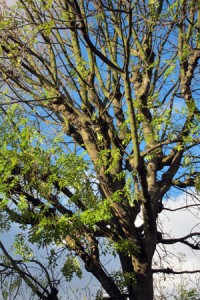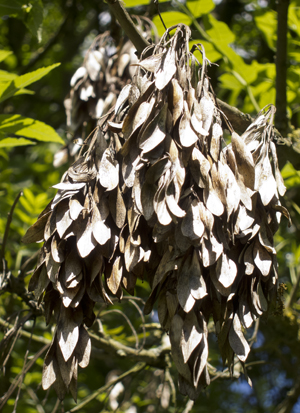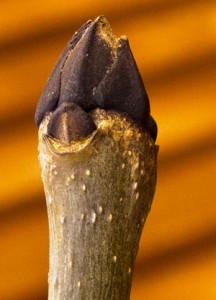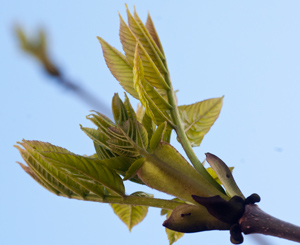Ash dieback – what to do? Pre-empt, plant, persevere, keep calm and carry on.

The last ice age endured for about 100,000 yrs. Some 18,000 yrs ago, mammoths, sabre-toothed tiger and woolly rhino (preyed on by prehistoric man) roamed our land. Thick ice sheets lay to the North, whilst to the South was tundra - much like that now seen in Northern Siberia. Then 10,000 years later, the ice sheets started to melt and the tundra receded; sea levels rose and low lying areas were flooded. The North Sea and English Channel formed, cutting us off from mainland Europe. This was a gradual process (in our terms) and as Europe warmed, trees migrated northwards - some reaching the UK before we were cut off from the rest of Europe. Most plant colonisation was by seed and spores, animals followed bringing with them other taxa.
We, as a group of islands, had a depleted stock of trees, probably harbouring fewer pathogens or diseases to which the trees had resistance. Forests formed, their make up or species composition changed with changing climate. We cleared most of the forests, probably some 4,000 years ago. By contrast, mainland Europe had a much wider assemblage, different pathogens and a tree stock resistant to some.
Will we ever learn?
 Since then, we have introduced many useful trees species for timber production and ornament, mostly grown from seed and propagated here so these come without disease. As Britain has a natural barrier to pathogens from mainland Europe, our indigenous trees have grown without them; they may not have natural immunity. Our sylvan history is littered with pathogens we have imported plants and plant material (including timber) from all corners of the world. Dutch elm disease was introduced on logs imported from Canada – one forester told me the logs still underbark at dockside were ‘heaving’ with insects! Phytophthora ramorum came to us through imports - probably from Asia.
Since then, we have introduced many useful trees species for timber production and ornament, mostly grown from seed and propagated here so these come without disease. As Britain has a natural barrier to pathogens from mainland Europe, our indigenous trees have grown without them; they may not have natural immunity. Our sylvan history is littered with pathogens we have imported plants and plant material (including timber) from all corners of the world. Dutch elm disease was introduced on logs imported from Canada – one forester told me the logs still underbark at dockside were ‘heaving’ with insects! Phytophthora ramorum came to us through imports - probably from Asia.
The key issue is not how to deal with ash dieback but should we just stop mass imports of nursery stock and other plant material? We are quite capable of growing ash in our nurseries. If we want better stock then we can import the seed and raise seedlings here with little risk. Sending British local provenance seed to Holland or Hungary and then importing the transplants makes no sense at all. Do foresters realise where their plants have come from? Of course it may be a natural process, and all we are doing is speeding it up by regular imports of diseased stock! In the creation of new plantations and forests in recent times, we have imported hundreds of thousands of young trees.
 The Horticultural Trades Assoc (nursery stock trade body) could see the problem coming and have been lobbying a deaf DEFRA. The Secretary of State assures us they have acted quickly and with urgency – hmm! Is the Council of Europe any better prepared or following a coherent strategy?
The Horticultural Trades Assoc (nursery stock trade body) could see the problem coming and have been lobbying a deaf DEFRA. The Secretary of State assures us they have acted quickly and with urgency – hmm! Is the Council of Europe any better prepared or following a coherent strategy?
I rather disagree with Peter Marren’s view, Independent 2nd Nov, see : http://www.independent.co.uk/voices/comment/its-not-neglect-its-our-love-of-planting-trees-that-has-caused-this-disaster-8278106.html . Tree planting isn’t new for foresters, it’s a continuous process. Yes, there has been some new planting by landowners and farmers, but our problem is import related rather than our love of trees. Trees and forests form the natural vegetation in the UK, perhaps our problem is there are just too few trees to absorb the waves of disease?
Patrick Barkham’s analysis in the Guardian 30th Oct, see : http://www.guardian.co.uk/environment/2012/oct/30/ash-tree-crisis-dieback-disease?INTCMP=SRCH describes our problem in his essay “The ash tree crisis: a disaster in the making”
 I wonder if the Bishop of Liverpool and his panel of experts are feeling a little embarrassed now, the sale of some of the Forestry Commission woodlands is such a minor issue in comparison. Certainly the Forestry Commission (and Government) will need all its funds to contend with ash dieback and there will be no money for the Bishop’s wish list. As for the coalition government, if they want to do something for human health then ban ‘trans fats’ (there’s much talk of human health in the report).
I wonder if the Bishop of Liverpool and his panel of experts are feeling a little embarrassed now, the sale of some of the Forestry Commission woodlands is such a minor issue in comparison. Certainly the Forestry Commission (and Government) will need all its funds to contend with ash dieback and there will be no money for the Bishop’s wish list. As for the coalition government, if they want to do something for human health then ban ‘trans fats’ (there’s much talk of human health in the report).
What to Do? Pre-empt, Plant, Persevere, Keep Calm and Carry on.
Ash dieback is more than likely here and will spread. There’s probably little we can do now to stop it. Get planting, plan for the worst case scenario, for ornamentals get another species in nearby, if the ash succumbs your trees will be large enough to show. In woodlands start thinning any ash, restock with another species. Think continuous cover, underplant for the future and not clearfell.
https://www.woodlands.co.uk/blog/tree-identification/ash/
Comments are closed for this post.
Discussion
The planting policy stuff is a red herring really. Most of the infected sites aren’t planted: mostly, it’s being blown in on the wind or carried by birds from the continent. That’s why the non-planted sites are all near the east coast, but it will spread out from there across the land just as it has spread westwards from Poland in the last 20 years.
Rigorous quarantine wouldn’t have stopped all this from happening.
Might interest
http://www.crowders.co.uk/blog/crowders-ash-tree-dieback/
What species of tree would you recommend for restocking in a hedgerow (East Anglian boulder clay soil)in terms of something that grows relatively fast, preferably native, makes good firewood?
Was thinking about Lime, Alder, Field Maple.
Thanks.

As a forester and nursery owner, I disagree with Iain.
The main infection is from the massive importation of ash from Holland for planting by woodland trust, forestry commision, private forestry, private landowners and so called “UK nurseries” who do not breed or grow just sell on imported cheap Dutch imports but claim to be Bristish.
Look at the distribution of these nurseries and the planting schemes you will see an eastern bias and the spread of die back in the UK has not been even and just from the East but from plantations
mike
8 August, 2014